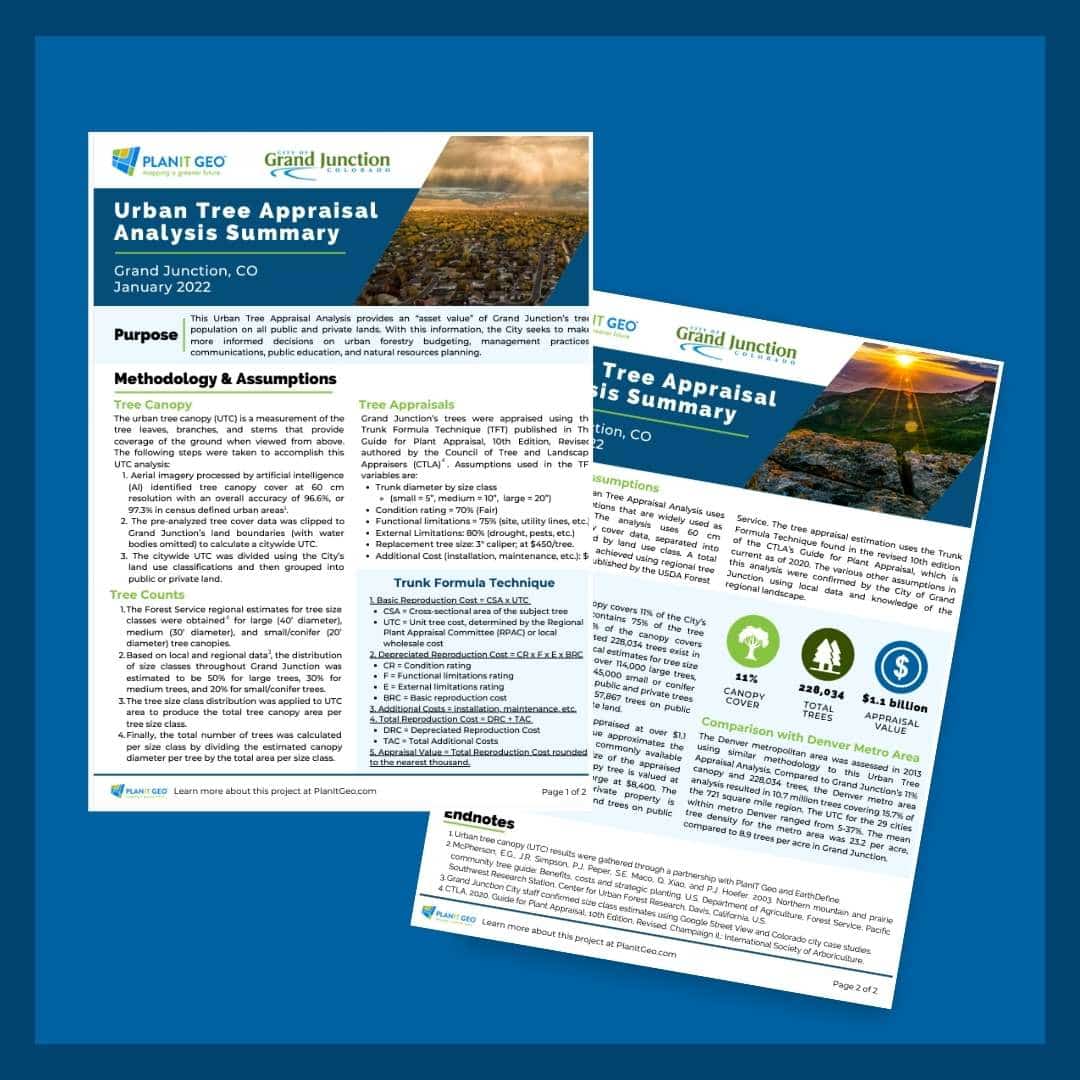Urban Tree Appraisal Analysis Summary
Grand Junction, CO, USAGrand Junction Urban Tree Appraisal Analysis
PURPOSE
This Urban Tree Appraisal Analysis provides an “asset value” of Grand Junction’s tree population on all public and private lands. With this information, the City seeks to make more informed decisions on urban forestry budgeting, management practices, communications, public education, and natural resources planning.
METHODOLOGY AND ASSUMPTIONS
TREE CANOPY
The urban tree canopy (UTC) is a measurement of the tree leaves, branches, and stems that provide coverage of the ground when viewed from above. The following steps were taken to accomplish this UTC analysis:
- Aerial imagery processed by artificial intelligence (AI) identified tree canopy cover at 60 cm resolution with an overall accuracy of 96.6%, or 97.3% in census defined urban areas .
- The pre-analyzed tree cover data was clipped to Grand Junction’s land boundaries (with water bodies omitted) to calculate a citywide UTC.
- The citywide UTC was divided using the City’s land use classifications and then grouped into public or private land.
TREE COUNTS
- The Forest Service regional estimates for tree size classes were obtained for large (40’ diameter), medium (30’ diameter), and small/conifer (20’ diameter) tree canopies.
- Based on local and regional data , the distribution of size classes throughout Grand Junction was estimated to be 50% for large trees, 30% for medium trees, and 20% for small/conifer trees.
- The tree size class distribution was applied to UTC area to produce the total tree canopy area per tree size class.
- Finally, the total number of trees was calculated per size class by dividing the estimated canopy diameter per tree by the total area per size class.
TREE APPRAISALS
Grand Junction’s trees were appraised using the Trunk Formula Technique (TFT) published in The Guide for Plant Appraisal, 10th Edition, Revised, authored by the Council of Tree and Landscape Appraisers (CTLA) . Assumptions used in the TFT variables are:
- Trunk diameter by size class (small = 5”, medium = 10”, large = 20”)
- Condition rating = 70% (Fair)
- Functional limitations = 75% (site, utility lines, etc.)
- External Limitations: 80% (drought, pests, etc.)
- Replacement tree size: 3″ caliper; at $450/tree.
- Additional Cost (installation, maintenance, etc.): $0
Key Insights
Total Trees
Appraisal Value
Tree Canopy Cover
SUMMARY OF ASSUMPTIONS
Grand Junction’s Urban Tree Appraisal Analysis uses methods and assumptions that are widely used as industry standards. The analysis uses 60 cm resolution tree canopy cover data, separated into public and private land by land use class. A total citywide tree count was achieved using regional tree size class assumptions published by the USDA Forest Service. The tree appraisal estimation uses the Trunk Formula Technique found in the revised 10th edition of the CTLA’s Guide for Plant Appraisal, which is current as of 2020. The various other assumptions in this analysis were confirmed by the City of Grand Junction using local data and knowledge of the regional landscape.
RESULTS
Grand Junction’s tree canopy covers 11% of the City’s land area. Private land contains 75% of the tree canopy, whereas only 25% of the canopy covers public property. An estimated 228,034 trees exist in Grand Junction. Based on local estimates for tree size class distribution, there are over 114,000 large trees, 68,000 medium trees, and 45,000 small or conifer trees. A closer examination of public and private trees shows an estimated total of 57,867 trees on public land and 170,167 trees on private land.
Grand Junction’s trees are appraised at over $1.1 billion. This tree appraisal value approximates the costs to purchase the largest commonly available nursery trees relative to the size of the appraised trees. As such, each small canopy tree is valued at $500, medium at $2,100, and large at $8,400. The total value of all trees on private property is estimated at over $838 million, and trees on public property over $285 million.
COMPARISON WITH DENVER METRO AREA
The Denver metropolitan area was assessed in 2013 using similar methodology to this Urban Tree Appraisal Analysis. Compared to Grand Junction’s 11% canopy and 228,034 trees, the Denver metro area analysis resulted in 10.7 million trees covering 15.7% of the 721 square mile region. The UTC for the 29 cities within metro Denver ranged from 5-37%. The mean tree density for the metro area was 23.2 per acre, compared to 8.9 trees per acre in Grand Junction.

